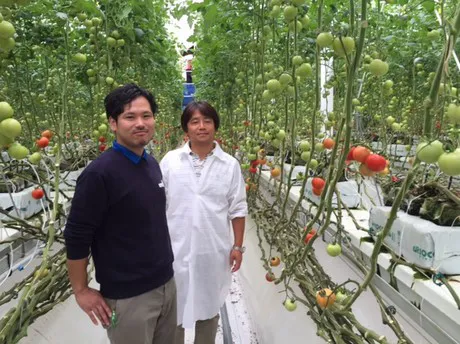
Koshi Fujimaki, head grower at Akeno Green Farm and Satoshii Harada, manager of Kagome's fresh produce division.
"We are currently harvesting fruits from the first crop," said Harada when we asked him about the current crop. "We planted this variety in January, and we expect to finish the crop by the end of November."
Looking back on the first season, the growers at Kagome are pleased with the Ultra Clima greenhouse. The first year was challenging for them, but they knew that they had to learn how to work with this new way of growing. "We had the privilege to work together with consultant Peter Statow, who has a lot of experience with growing in an Ultra Clima greenhouse. Mr. Statow is also growing in one in the south of France, where the climate is more or less similar to the climate in Japan."
Despite many challenges in the first year, the Japanese grower expects to achieve a good overall production. "Right now, we have picked 60 kg/sq.m., we expect that we will achieve more than 70 kg/sq.m. when the crop is finished."
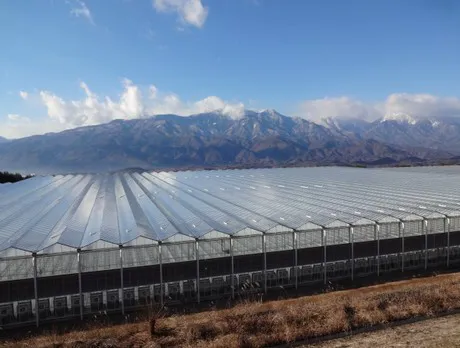
The growers of Kagome opted for the very advanced Ultra-Clima greenhouse after several years of research. The benefits of precise climate control, more light in the greenhouse, higher CO2 levels and energy savings were all important factors. "Thanks to the advanced overpressure technology, the climate in the greenhouse is much more stable than in the traditional greenhouses that we also have. We can keep higher CO2 levels in the greenhouse which is extremely beneficial to the overall quality and production numbers.".
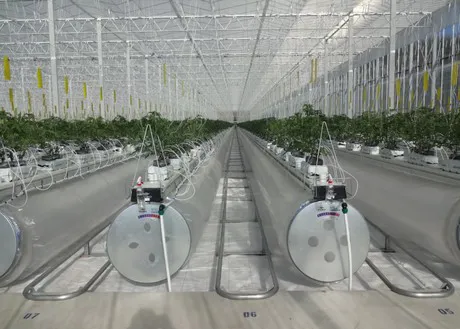
While the Ultra-Clima technology has proven itself in other extreme climates, such as California, the Japanese Climate is asking for a different approach. Harada: "We have to deal with very high humidity levels, after the rainy season it can be extremely humid in June. This makes it challenging, but the advanced technology and supplies help us to achieve the best."
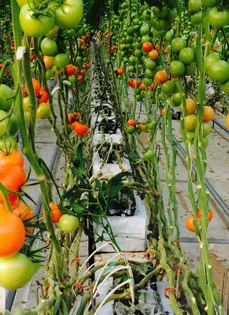
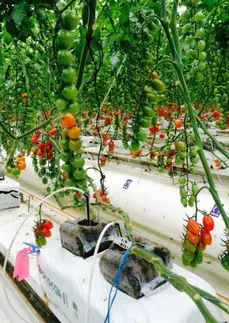
In order to create outstanding results, Kagome also works in close collaboration with other companies, such as substrate supplier Riococo. They grow all of their crops inside the Ultra-Clima greenhouse on their coir substrate. Together with Riococo, a special mix was created for Kagome in order to provide a well balanced rooting environment for the crop from the start. Just like learning how to grow in an Ultra-Clima, Riococo and Kagome had to preform extensive research for the best growing media composition that was suitable for growing inside the Ultra-Clima at Akeno.
"The climate in Japan tends to steer the crop very generative, which requires a special substrate to support the demand from the crop. The mix from Riococo helps us to achieve good results, its contributes to growing successfully in the Ultra Clima greenhouse," said Harada.
Besides the good performance of the substrate bag, Kagome also prefers coir propagation blocks instead of the more often seen stonewool propagation cubes. According to Riococo's Shan Halamba, the combination coco bags and blocks helps to establish a faster rooter and prevents root shock.
According to Harada, the propagation of the young plants in coir fits them well, and they prefer to have an all organic, sustainable combination. "Coir is a good propagation media, the combination of the Riococo growbags and the propagation cubes is a sustainable combination. After our crop change, we support local farmers with the waste material that is enriched with useful nutrients, they can use this as fertilizers for open field production."
For more information:
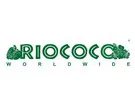
Riococo
[email protected]
www.riococo.com
KUBO Sustainable Greenhouse Projects

[email protected]
www.kubo.nl/en
